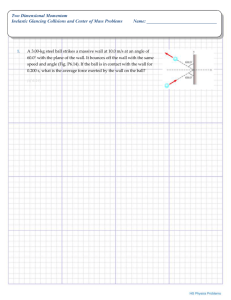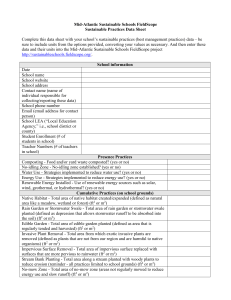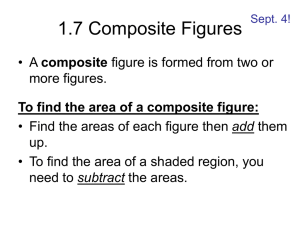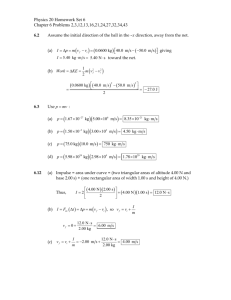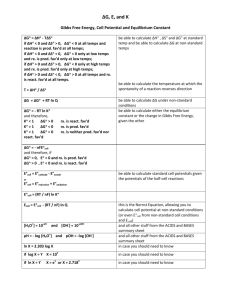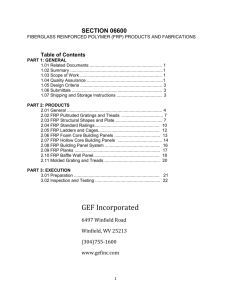2D Momentum, Collisions & Center of Mass Worksheet
advertisement
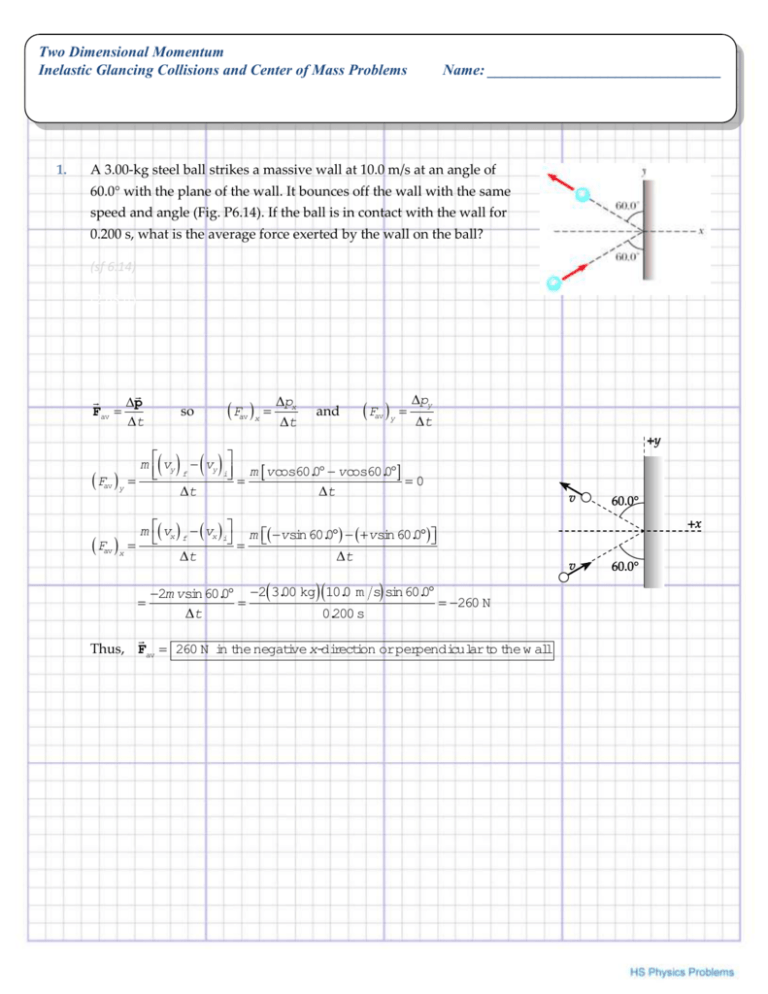
Two Dimensional Momentum Inelastic Glancing Collisions and Center of Mass Problems 1. Name: _______________________________ A 3.00-kg steel ball strikes a massive wall at 10.0 m/s at an angle of 60.0° with the plane of the wall. It bounces off the wall with the same speed and angle (Fig. P6.14). If the ball is in contact with the wall for 0.200 s, what is the average force exerted by the wall on the ball? (sf 6.14) (2.68 ft) Fav p t Fav x so v m vy Fav y f t y i px t and Fav y py t m vcos60.0 vcos60.0 0 t m vx f vx i m vsin60.0 vsin60.0 Fav x t t 2m vsin60.0 2 3.00 kg10.0 m s sin60.0 260 N t 0.200 s Thus, Fav 260 N in the negative x-direction orperpendicularto the w all 2. A 90-kg fullback moving east with a speed of 5.0 m/s is tackled by a 95-kg opponent running north at 3.0 m/s. If the collision is perfectly inelastic, calculate the velocity of the players just after the tackle. (sf 6.41) (6.13 m) Choose the +x-axis to be eastward and the +y-axis northward. First, we conserve momentum in the x direction to find 185 kg V cos 90 kg 5.0 m s , or V cos 185 5.0 m s 90 (1) Conservation of momentum in the y direction gives 185 kg V sin 95 kg 3.0 m s , or V sin 185 3.0 m s 95 Divide equation (2) by (1) to obtain tan 95 3.0 , and 90 5.0 32 Then, either (1) or (2) gives V = 2.88 m s, which rounds to V 2.9 m s (2) 3. An 8.00-kg object moving east at 15.0 m/s on a frictionless horizontal surface collides with a 10.0-kg object that is initially at rest. After the collision, the 8.00-kg object moves south at 4.00 m/s. What is the velocity of the 10.0-kg object after the collision? (sf 6.42) (36.1 m/s at 60.1° below the horizontal) Choose the +x-axis to be eastward and the +y-axis northward. Conserving momentum in the x direction gives 0 10.0 kg v2x 8.00 kg 15.0 m s 0 , or v2x 12.0 m s Momentum conservation in the y direction yields 8.00 kg 4.00 m s 10.0 kg v 2y 0 0 , or v2y 3.20 m s After collision, v2 v22x v22y 154 m s 12.4 m s and 3.20 v2y tan 1 14.9 . Thus, the final velocity of the 10.0-kg mass is v2x 12.0 tan 1 v2 12.4 m s at14.9 N ofE 4. A 2,000-kg car moving east at 10.0 m/s collides with a 3 000-kg car moving north. The cars stick together and move as a unit after the collision, at an angle of 40.0° north of east and a speed of 5.22 m/s. Find the speed of the 3 000-kg car before the collision (sf 6.43) (12 m/s) Choose the +x-axis to be eastward and the +y-axis northward. If vi is the initial northward speed of the 3000-kg car, conservation of momentum in the y direction gives 0 3000 kg vi 5000 kg 5.22 m s sin 40.0 , or vi 5.59 m s Observe that knowledge of the initial speed of the 2000-kg car was unnecessary for this solution. 5. A water molecule consists of an oxygen atom with two hydrogen atoms bound to it as shown in the figure. The bonds are 0.100 nm in length, and the angle between the two bonds is 106°. Use the coordinate axes shown, and determine the location of the center of gravity of the molecule. Take the mass of an oxygen atom to be 16 times the mass of a hydrogen atom. (sf 8.8) (7.23 x 103 m, 1.68 x 103 m) If the mass of a hydrogen atom is 1.00 u (that is, 1 unit), then the mass of the oxygen atom is 16.0 u. xcg m ixi 16.0 u 0 21.00 u 0.100 nm cos53.0 6.69 103 nm m i 16.0 1.00 1.00 u ycg m iyi m i 16.0 0 1.00 0.100 sin53.0 1.00 0.100 sin53.0 u nm 16.0 1.00 1.00 u 0 7. Find the x- and y-coordinates of the center of gravity of a 4.00-ft by 8.00-ft uniform sheet of plywood with the upper right quadrant removed as shown in the figure. (sf 8.11) (25 m) Consider the remaining plywood to consist of two parts: A 1 is a 4.00-ft by 4.00-ft section with center of gravity located at 2.00 ft,2.00 ft , while A 2 is a 2.00-ft by 4.00-ft section with center of gravity at 6.00 ft,1.00 ft . Since the plywood is uniform, its mass per area is constant and the mass of a section having area A is m A . The center of gravity of the remaining plywood has coordinates given by: and xcg 16.0 ft2 2.00 ft 8.00 ft2 6.00 ft m ixi A 1x1 A 2x2 3.33 ft m i A1 A 2 16.0 ft2 8.00 ft2 ycg 16.0 ft2 2.00 ft 8.00 ft2 1.00 ft m iyi A 1y1 A 2y2 1.67 ft m i A1 A 2 16.0 ft2 8.00 ft2
